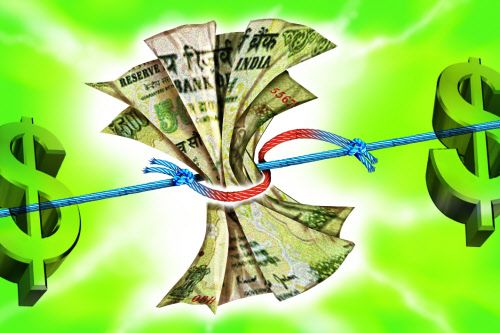 By Ira Sharma
By Ira Sharma
The rupee has plunged to an all time low against dollar. In simple words, the rupee depreciation means the value of Indian currency has gone down against dollar. Many macro economic matters such as slow economic growth, huge current account deficit, rising imports, etc are brought up in the scenario by usual discussions over fall in the value of rupee. How can one think of the rising differences between rupee & dollar given that at the time of independence, when India had no foreign borrowings, the rupee was at par with the dollar. Then, with the introduction of 5 year plans, the subsequent requirement for foreign investment, Bofors scam in 1985, economic liberalization in 1991, and at last the dawn of the third millennium, worsened the condition of rupee against dollar and it hit an all time low of 68 against a dollar. One of the most important question that many are asking is why has rupee fallen to its current state?
It’s important to know that the rupees value is directly linked to the amount of US dollars available in the Indian market. India receives dollars in 3 ways: through exports, through foreign investment, and through NRI remittances into India. Less the number of dollars in the market, the more is the dolar’s worth (basic law of demand and supply) and so, the rupee depreciates. The current account deficit is a measure that easily tells us the difference between exports and imports, and hence is a good indicator for the supply of US dollars and other major currencies. If country’s current account deficit is seen rising, it means that the country is importing more goods than exporting. In case of India, each successive month the current account deficit has been rising at a dangerously alarming rate. It is a worrying sign which leads to rupee depreciation. In addition India’s main import is crude oil, it imports close to 70% of its net fuel requirement and the countries it imports from, unfortunately accept only dollars or other major currencies. It means that the companies importing oil have to shell out more rupees for the same dollar invoice. This has severely impacted the bottom line of these companies as well as subsidy bill of the Indian government.
 The falling rupee has added further to the inflationary pressure, as imports have become costlier and thus increasing the prices of key commodities such as oil, imported coal, minerals and metals. However, the falling rupee has substantially appreciated the revenue for the exporters, who receive more rupees for their dollar receipts. Other than this, the major duty of RBI is to continuously control the supply of currency in the Indian market. However, RBI knowing the free falling trend of rupee can accomplish two tasks in one shot: control Indian’s rising inflation and control the depreciation of the rupee, simply by limiting the supply of the currency. India’s urbanisation is not going to stop, wages will continue to rise and inflation will be controlled since, the money supply can be kept at par with GDP growth. The government needs to address the rising current account deficit and slow growth until optimism finally settles in.
The falling rupee has added further to the inflationary pressure, as imports have become costlier and thus increasing the prices of key commodities such as oil, imported coal, minerals and metals. However, the falling rupee has substantially appreciated the revenue for the exporters, who receive more rupees for their dollar receipts. Other than this, the major duty of RBI is to continuously control the supply of currency in the Indian market. However, RBI knowing the free falling trend of rupee can accomplish two tasks in one shot: control Indian’s rising inflation and control the depreciation of the rupee, simply by limiting the supply of the currency. India’s urbanisation is not going to stop, wages will continue to rise and inflation will be controlled since, the money supply can be kept at par with GDP growth. The government needs to address the rising current account deficit and slow growth until optimism finally settles in.

































